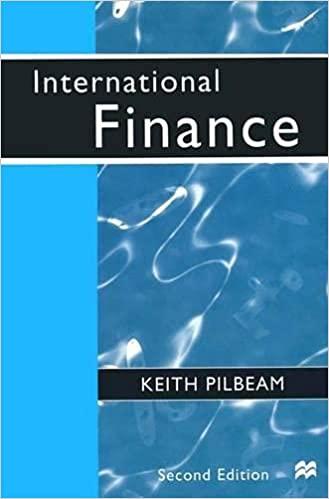Question
Mark and John are rational, risk-averse investors who allocate between risky and risk-free assets so that their target risk exposure is consistent with their level
Mark and John are rational, risk-averse investors who allocate between risky and risk-free assets so that their target risk exposure is consistent with their level of risk aversion. In addition, they both select the portfolio of risky assets that delivers the highest risk premium per unit of total risk. Both Mark and John can borrow or lend at the risk-free rate. For the risky portfolio, both Mark and John allocate their investment funds to the XYZ Fund. The fund charges no fees.
(a) Mark observes that rational, risk-averse investors will hold the portfolio with the highest Sharpe ratio. If this is the case, no investor will buy the market portfolio. Instead, all investors will only invest in the risk-free asset, since the Sharpe ratio for the risk-free rate is infinite. Do you agree or disagree with Mark? Answer why you think so in three sentences or less. For Question (b) only, assume XYZ is perfectly positively correlated with the market portfolio XYZ = 1. (b) Both Mark and John think if investors select portfolios with the highest Sharpe ratio, then investors will never choose to invest in mutual funds that are not (1) the market portfolio, or (2) index funds like XYZ, which perfectly track the market portfolio. Do you agree or disagree with them? Answer why you think so in three sentences or less. For Question (c) only, use the following information: Suppose that securities markets are in a no-arbitrage (APT) equilibrium such that:
rXYZ = rf + XYZ,M (rM - rf) + XYZ,IR(rIR - rf)
where M is the market portfolio and IR is the interest rate risk factor portfolio. Also, assume that the XYZ Fund is well diversified across the two factors, with the following factor loadings: Factor Risk - Factor Loadings - Expected Returns and/or Risk Premiums
M = 0.2 - XYZ,M = 0.5 - E(rM) = 0.05
IR = 0.1 - XYZ,IR = -0.5 - E(rIR) - rf = 0.02
rf = 0.01
(c) John states that according to his analysis, E(rXYZ) = 2%, and there is an arbitrage opportunity. Is John correct? If yes, describe the trading strategy to exploit the mispricing. What are weights for each of the assets in the portfolio? What do you buy, short sell, borrow and/or lend? If no, explain why there is no arbitrage opportunity in three sentences or less. (d) Mark calculates corr(rm,t, rIR,t) = 0.1. Does your answer to question (c) change? Answer yes or no, and explain why you think so in three sentences or less. No calculations required. For Question (e) only, assume that securities markets are well-approximated by the CAPM equilibrium, and that estimated from an index model equals zero. The estimated index model is:
rXYZ,t rf,t = + XYZ,M(rM,t rf,t) + e XYZ,t
(e) At t+1, John observes XYZ,M(rM,t+1 rf,t+1) = -0.06 and rXYZ,t+1 = -0.04. John states Between t and t+1, there definitely was good news about XYZ and bad news about the market. Do you agree or disagree with John? Answer why you think so in five sentences or less.
Step by Step Solution
There are 3 Steps involved in it
Step: 1

Get Instant Access to Expert-Tailored Solutions
See step-by-step solutions with expert insights and AI powered tools for academic success
Step: 2

Step: 3

Ace Your Homework with AI
Get the answers you need in no time with our AI-driven, step-by-step assistance
Get Started


